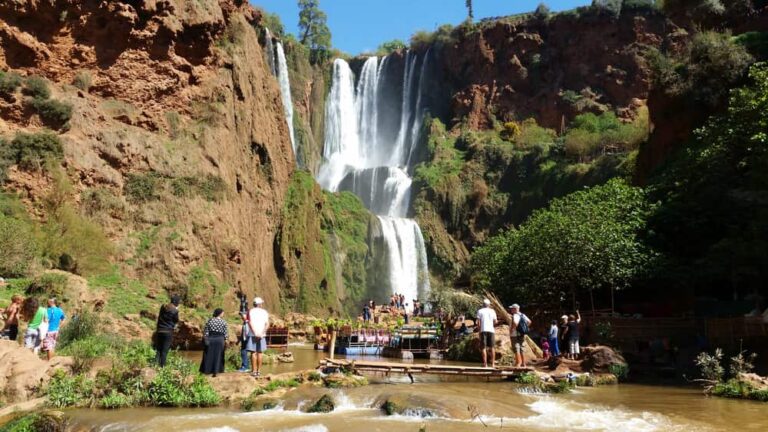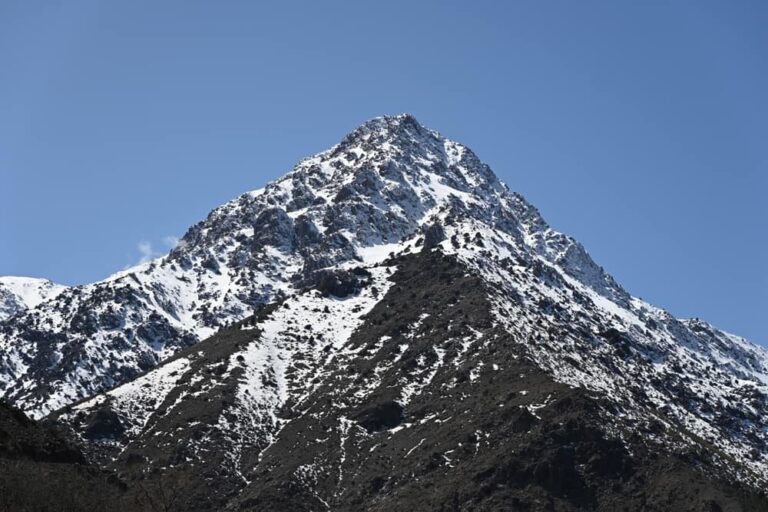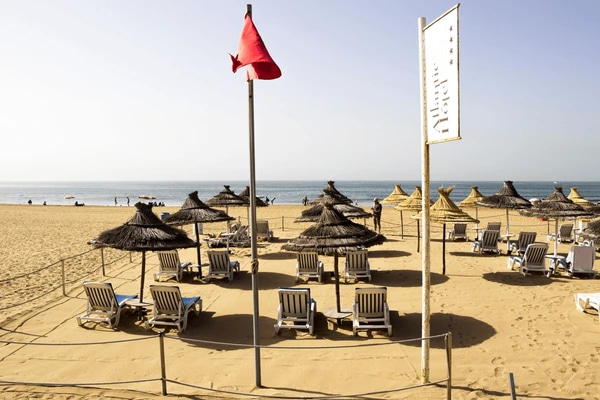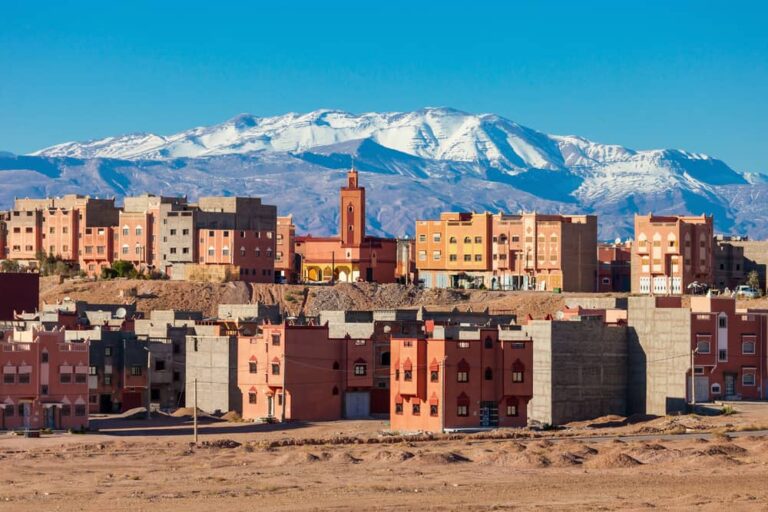Ourika Valley
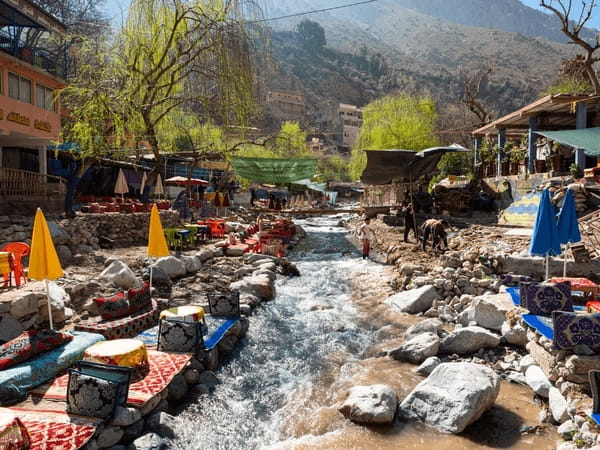
The Ourika Valley, nestled in the foothills of the High Atlas Mountains in Morocco, is a tranquil escape just a short drive from the busy city of Marrakech. Known for its stunning natural beauty, lush landscapes, and deep cultural roots, the valley has become a popular spot for visitors seeking a peaceful retreat into nature. Its proximity to Marrakech makes it ideal for a day trip, though many find its charm and attractions worthy of a longer stay.
The valley is home to the Amazigh people (also known as Berbers), who have lived in the region for centuries. Their unique culture, including traditional mountain architecture and agricultural practices, adds a rich layer of history to the natural beauty of the area. Almond and olive trees dot the valley, along with flowing rivers and waterfalls, creating a landscape that feels like stepping back in time.
Geography of the Ourika Valley
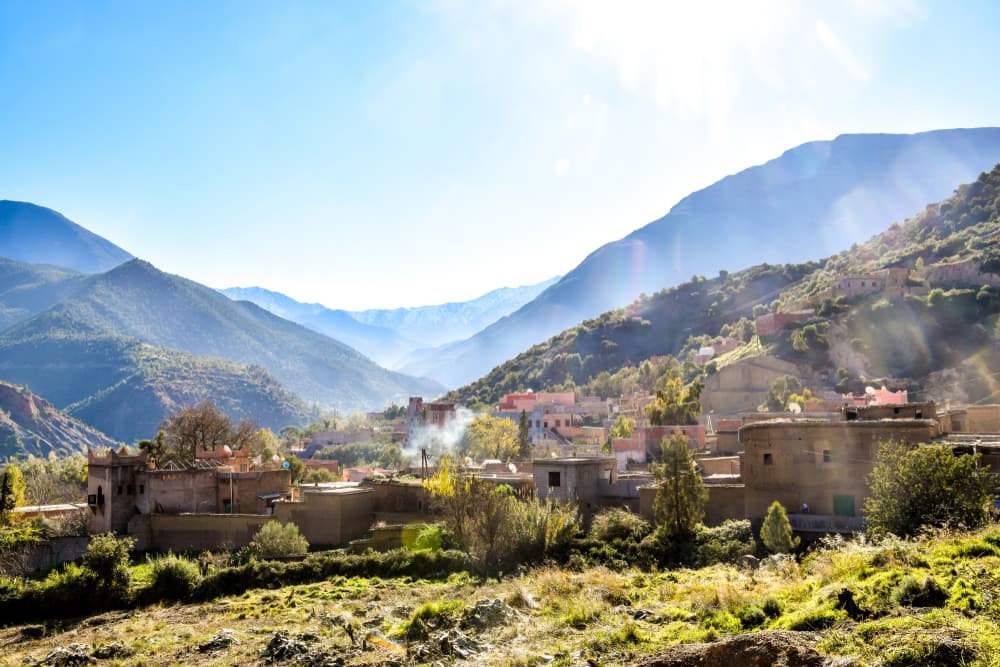
The Ourika Valley is about 30 kilometers (18.6 miles) from Marrakech, following the course of the Ourika River, which runs down from the Atlas Mountains. This river has shaped the valley’s geography over the centuries, creating a fertile and well-watered area where lush vegetation thrives. The valley is part of the larger High Atlas region, a range of mountains that stretches across North Africa, reaching heights of up to 4,167 meters (13,671 feet) at Mount Toubkal, the highest peak in the Atlas Mountains and Morocco.
The lower part of the valley is characterized by rolling hills and terraced fields, where the locals grow various crops, including fruits, vegetables, and the famous argan and olive trees. As you travel deeper into the valley, the landscape becomes more rugged, with cliffs and jagged rock formations—the High Atlas Mountains tower above, creating a dramatic backdrop for the valley.
Berber villages are scattered throughout the valley, often built into the hillsides using traditional techniques. The homes are typically made from local materials like clay and stone, blending seamlessly into the landscape. These villages, including Setti Fatma, are not only beautiful but also offer a glimpse into the traditional way of life of the Amazigh people. The geography of the Ourika Valley makes it an ideal destination for hiking, trekking, and nature exploration, with trails that lead through the valley, up into the mountains, and alongside the Ourika River.
Best Places to Visit in the Ourika Valley
The Ourika Valley is a popular and beautiful destination for visitors looking to escape the busy streets of Marrakech and immerse themselves in nature and Berber culture. Below are the most notable places and attractions you should explore during your visit, each offering unique experiences that showcase the charm of the valley.
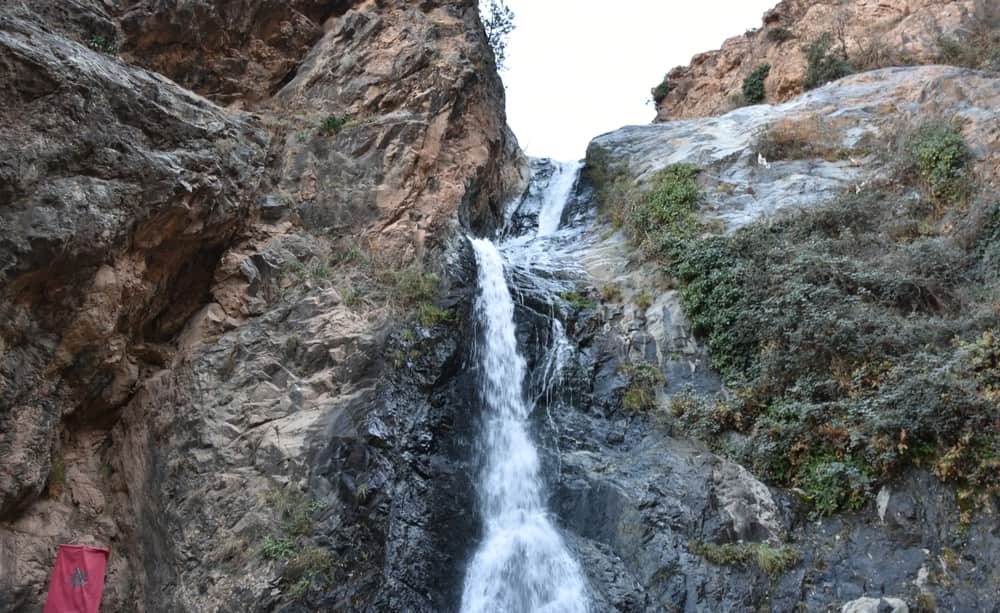
1. Setti Fatma Waterfalls
The Setti Fatma Waterfalls are perhaps the most famous attraction in the Ourika Valley. Located near the small village of Setti Fatma, these waterfalls are a series of seven cascades that flow down from the surrounding mountains. The hike to reach the waterfalls is one of the main reasons travelers visit this area. The journey starts in the village and takes you through scenic terrain, including rocky paths, terraced fields, and small streams.
While the hike can be challenging in some areas due to steep and uneven terrain, it’s accessible to most visitors, including families. For those who prefer not to hike, local guides and mule services are available to help you navigate the trail. Once you reach the top, you’ll be rewarded with the sight of the stunning waterfalls, as well as the opportunity to cool off in the clear waters.
2. Berber Villages
One of the best cultural experiences in the Ourika Valley is visiting the traditional Berber villages scattered across the region. These villages, such as Setti Fatma, Tnine Ourika, and Aghbalou, offer a glimpse into the daily lives of the Amazigh (Berber) people who have lived in these mountains for centuries. The architecture is typically made from local materials such as clay and stone, blending seamlessly into the natural landscape.
Visitors are often welcomed into local homes to experience Berber hospitality, where they can learn about traditional crafts like weaving, pottery, and the production of argan oil. Some villages have small local markets where handmade rugs, jewelry, and pottery can be purchased. Exploring these villages also allows visitors to see terraced farms and olive groves that have been cultivated by the Berber people for generations.
3. Anima Garden
Anima Garden, designed by Austrian artist André Heller, is one of the most beautiful and unique spots in the Ourika Valley. This magical garden is a blend of art, nature, and culture, filled with exotic plants, flowers, and sculptures. Walking through the garden feels like wandering through a living museum, with colorful displays at every turn. The garden also offers stunning views of the surrounding mountains, making it a peaceful place to relax and appreciate the beauty of nature.
Visitors to the garden can also enjoy a cup of Moroccan mint tea or a light meal at the garden’s café, which is surrounded by plants and flowers. The Anima Garden is perfect for families, art lovers, and anyone looking for a tranquil escape from the busier tourist spots.
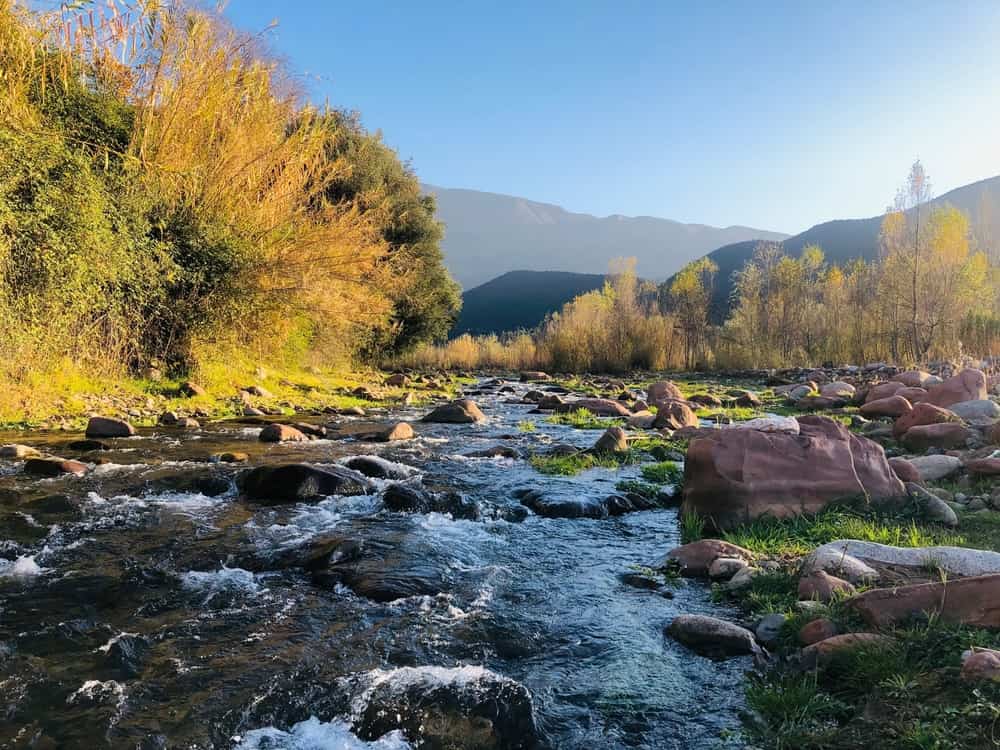
4. Ourika River
The Ourika River is the lifeblood of the valley, flowing down from the High Atlas Mountains and sustaining the local agriculture. The river winds its way through the valley, creating a peaceful and refreshing environment. Many of the small restaurants and cafés are located along the riverbanks, offering visitors the chance to enjoy traditional Moroccan dishes while taking in the views of the flowing water and surrounding mountains.
The river is also a great spot for picnicking, especially during the summer months when the temperatures rise. Families often gather by the water to cool off, and the river’s cool breeze makes it a refreshing escape from the heat. Additionally, nature lovers can take leisurely walks along the riverbanks to enjoy the tranquility of the valley.
5. Bio-Aromatic Garden of Ourika
Located near the village of Tnine Ourika, the Bio-Aromatic Garden of Ourika is another must-visit for those interested in Morocco’s unique plants and herbs. This garden is dedicated to the cultivation of aromatic and medicinal plants that are traditionally used in Moroccan cuisine, medicine, and cosmetics. A guided tour of the garden allows visitors to learn about the various plants and their uses, including how they are transformed into products like argan oil, herbal teas, and natural skincare items.
In addition to exploring the garden, visitors can participate in workshops where they learn to create their natural products, such as herbal oils and soaps. The Bio-Aromatic Garden is a wonderful destination for anyone interested in the rich biodiversity of Morocco and its traditional herbal remedies.
6. Toubkal National Park
Although technically located outside the Ourika Valley, Toubkal National Park is close enough that it is often included in the valley’s top destinations. The park is home to Mount Toubkal, the highest peak in North Africa, which attracts hikers and climbers from around the world. Even if you’re not up for climbing to the summit, the park offers numerous hiking trails that provide breathtaking views of the High Atlas Mountains.
The park’s diverse landscapes include alpine meadows, forests, and dramatic cliffs, making it a popular destination for nature lovers. Wildlife enthusiasts may also spot Barbary macaques, wild goats, and various bird species. For those visiting the Ourika Valley, a day trip to Toubkal National Park offers an unforgettable adventure in the heart of the Atlas Mountains.
7. Traditional Berber Markets
The Ourika Valley is home to several traditional markets, where locals gather to sell and trade their goods. The most famous market is held in Tnine Ourika every Monday. Here, visitors can experience the bustling energy of a true Moroccan market, where vendors sell fresh produce, spices, traditional Berber handicrafts, and textiles. The market is a great place to pick up souvenirs like handwoven rugs, pottery, and jewelry, all made by local artisans.
In addition to shopping, the market offers a chance to experience everyday life in the valley, as locals come together to socialize, trade, and shop for their weekly needs. It’s a lively and colorful experience that provides insight into the local culture and economy.
8. Argan Oil Cooperatives
The Ourika Valley is known for its production of argan oil, a valuable commodity in Morocco that is used for both cooking and cosmetic purposes. Many local cooperatives produce argan oil using traditional methods passed down through generations. A visit to one of these cooperatives offers the chance to see the process of extracting the oil from the nuts of the argan tree and learn about the various uses of this precious oil.
At the cooperatives, you can also purchase high-quality argan oil products directly from the source, including oils for cooking, skincare, and hair care. Visiting these cooperatives not only allows you to learn about the importance of argan oil to the local economy but also supports the women who are often the primary producers of this valuable resource.
9. Oukaïmeden Ski Resort
During the winter months, the nearby Oukaïmeden Ski Resort is a popular destination for those looking to enjoy winter sports. Located about an hour’s drive from the Ourika Valley, Oukaïmeden is one of the few places in North Africa where you can ski or snowboard. The resort has slopes for all levels of skiers, from beginners to advanced, and offers stunning views of the surrounding mountains covered in snow.
Even if you’re not into skiing, a trip to Oukaïmeden is worth it for the breathtaking winter scenery. The snow-capped peaks of the High Atlas Mountains create a stunning contrast against the blue sky, making it a perfect spot for photography and nature walks.
Ourika Valley Weather and Landscape
The weather in the Ourika Valley is relatively mild compared to the heat of Marrakech, making it a year-round destination. However, the climate does change with the seasons, and knowing what to expect can help you plan your visit.
Spring and Summer:
During the spring months (March to May), the valley is at its most beautiful. The landscape comes alive with blooming almond and olive trees, while wildflowers dot the fields and hillsides. The temperatures are pleasant, ranging from 15°C to 25°C (59°F to 77°F), making it an ideal time for outdoor activities like hiking and exploring the villages.
In the summer (June to August), the valley remains cooler than Marrakech, thanks to its higher elevation. Temperatures can reach 30°C (86°F) on hot days, but the shade from the trees and the cool breeze from the mountains make it comfortable. The Ourika River is also a popular spot for cooling off, and many visitors enjoy picnicking by the water.
Autumn and Winter:
Autumn (September to November) is another great time to visit the valley, with cooler temperatures and fewer tourists. The landscape takes on golden and red hues as the leaves change, and the atmosphere is calm and peaceful.
Winter (December to February) can be quite cold, especially in the higher elevations, where snow is common on the mountain peaks. The valley itself rarely sees snow, but the views of the snow-capped High Atlas Mountains are stunning. Winter is also a great time to visit if you enjoy skiing, as the nearby Oukaïmeden Ski Resort is only a short drive away.
The landscape of the Ourika Valley is diverse and ever-changing. From the flowing waters of the Ourika River to the rocky cliffs and green terraces, the valley offers a variety of scenery that changes with the seasons. Olive and almond trees provide shade and beauty, while the towering Atlas Mountains create a majestic backdrop.
What to See and Do in the Ourika Valley
The Ourika Valley offers a wide range of activities and attractions for visitors, from hiking and nature walks to cultural experiences and relaxation.
Hike to the Setti Fatma Waterfalls:
One of the most popular activities in the valley is the hike to the Setti Fatma waterfalls. Located near the village of Setti Fatma, these waterfalls are cascades flowing down from the mountains. The hike can be challenging in parts, especially as you climb higher, but the views are worth it. Along the way, you’ll pass by terraced fields, small streams, and rocky paths, all surrounded by lush greenery.

Explore the Berber Villages:
A visit to the Ourika Valley is not complete without exploring the traditional Berber villages that dot the landscape. These villages offer a glimpse into the culture and way of life of the Amazigh people. Many locals still practice traditional crafts, such as weaving and pottery, and visitors are often welcomed into homes to learn about Berber hospitality. Some popular villages to visit include Setti Fatma, Aghbalou, and Oulmes.
Visit the Anima Garden:
The Anima Garden is a unique attraction in the Ourika Valley, offering a blend of nature, art, and culture. Created by artist André Heller, this bio-aromatic garden is filled with colorful flowers, unique sculptures, and a variety of exotic plants. It’s a peaceful and relaxing place to stroll through, with plenty of photo opportunities. The garden also has a café where you can enjoy a cup of Moroccan mint tea while taking in the beautiful surroundings.
Experience Traditional Moroccan Cuisine:
Dining in the Ourika Valley is a special experience. Many small restaurants and cafés are located along the river, offering traditional Moroccan dishes like tagines, couscous, and grilled meats. The fresh ingredients, often sourced from local farms, make the food flavorful and authentic. Don’t forget to try Moroccan mint tea, a refreshing drink that is a staple of Moroccan hospitality.
Mule Treks and Nature Walks:
For those who prefer a more relaxed way to explore the valley, mule treks are a popular option. Local guides offer mule rides that take you through the valley, offering a slow-paced journey with plenty of time to take in the scenery. Nature walks along the Ourika River are another great way to enjoy the valley, with easy trails suitable for all ages.
Visit the Bio-Aromatic Garden:
Another gem in the valley is the Bio-Aromatic Garden, where visitors can explore a collection of aromatic and medicinal plants. The garden is dedicated to preserving Morocco’s rich biodiversity, and visitors can learn about the various plants used in traditional Moroccan medicine and cuisine. The garden also offers workshops on making natural products like herbal oils and soaps.
Bird Watching and Wildlife:
The Ourika Valley is home to a variety of bird species, making it a great destination for bird watching. You might also spot other wildlife, including Barbary macaques, which are native to the region. These playful monkeys can sometimes be seen near the river or in the forests surrounding the valley.
How to Get to the Ourika Valley from Marrakech
The Ourika Valley is an easy day trip from Marrakech, and there are several ways to reach the valley, depending on your budget and preference.
Private Transport:
The easiest and most comfortable way to get to the Ourika Valley is by private transport. You can hire a taxi or rent a car in Marrakech and drive to the valley, which takes about an hour. Many hotels and travel agencies also offer guided tours, which include transport, a guide, and stops at key attractions like Setti Fatma, the Anima Garden, and local Berber villages.
Public Transport:
For a more budget-friendly option, you can take a shared taxi or bus from Marrakech to the Ourika Valley. Shared taxis are common in Morocco and can be found at major taxi stands in Marrakech. The ride is usually less comfortable and slower than private transport, but it’s a great way to experience local life. Buses are another option, though they are less frequent and may not take you directly to your destination in the valley.
Once you arrive in the valley, it’s easy to get around on foot or by hiring a local guide to take you to specific attractions.
Practical Tips for Visiting the Ourika Valley
To make the most of your trip to the Ourika Valley, here are some practical tips to keep in mind:
- Best Time to Visit: Spring (March to May) and autumn (September to November) are the best times to visit, as the weather is mild and the landscape is at its most beautiful. Summer can be warm but still pleasant, while winter offers the chance to see snow in the mountains.
- What to Wear: Comfortable walking shoes are essential, especially if you plan to hike to the Setti Fatma waterfalls or explore the Berber villages. Layers are recommended, as temperatures can vary throughout the day.
- Dining: There are many small restaurants along the Ourika River, offering traditional Moroccan dishes. Be sure to try tagines, a slow-cooked stew, and couscous, a popular Moroccan dish. Moroccan mint tea is a must-try, especially when enjoyed with a view of the mountains.
- Payment: Bring cash, as many small shops, cafés, and restaurants in the valley do not accept credit cards. It’s also helpful to have small changes for tips or purchases from local artisans.
- Respect Local Culture: The Berber people are very welcoming, but it’s important to be respectful of their traditions. Always ask for permission before taking photos of locals, and dress modestly when visiting villages.
- Stay Hydrated: The dry mountain air and sun can be dehydrating, so be sure to carry water with you, especially if you plan on hiking or spending time outdoors.
Conclusion
The Ourika Valley is a remarkable destination that offers a perfect blend of natural beauty, cultural experiences, and outdoor adventures. Whether you’re hiking to the Setti Fatma waterfalls, exploring traditional Berber villages, or simply enjoying a meal by the river, the valley has something to offer every visitor. Its proximity to Marrakech makes it an easy and accessible day trip, but the valley’s charm often encourages visitors to stay longer.
By following the tips and recommendations in this guide, you’ll be well-prepared for your visit to the Ourika Valley. From its breathtaking landscapes to its rich cultural heritage, the valley promises an unforgettable experience for all who visit.
Frequently Asked Questions (FAQs)
How far is the Ourika Valley from Marrakech?
The Ourika Valley is approximately 30 kilometers (18.6 miles) from Marrakech, making it about a one-hour drive.
What is the best time to visit the Ourika Valley?
The best time to visit is in the spring or autumn when the weather is mild, and the landscape is at its most vibrant.
Are there guided tours available in the Ourika Valley?
Yes, many travel agencies and hotels in Marrakech offer guided tours to the Ourika Valley, which often include transportation and visits to key attractions.
Is the hike to Setti Fatma waterfalls difficult?
The hike can be challenging in some parts due to the rocky terrain, but it’s generally suitable for most visitors, including families with children. Local guides are available to help along the way.
Can I visit the Ourika Valley in one day?
Yes, the Ourika Valley is a popular day trip from Marrakech, but if you want to explore more in-depth or enjoy a relaxed pace, consider staying overnight.
What should I bring for a visit to the Ourika Valley?
Comfortable shoes, layered clothing, cash for purchases and meals, and water are essential for a visit to the valley.



